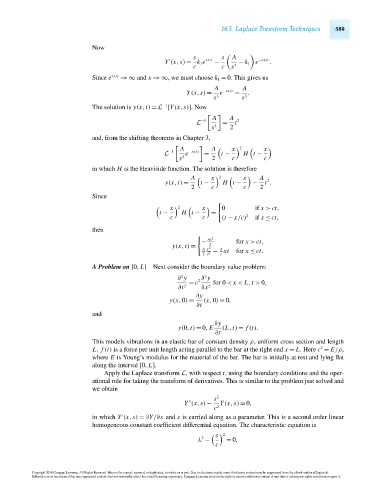Page 609 - Advanced_Engineering_Mathematics o'neil
P. 609
16.5 Laplace Transform Techniques 589
Now
s s A
Y (x,s) = k 1 e sx/c − − k 1 e −sx/c .
c c s 3
Since e sx/c →∞ and x →∞, we must choose k 1 = 0. This gives us
A A
Y(x,s) = e −sx/c − .
s 3 s 3
−1
The solution is y(x,t) = L [Y(x,s)].Now
A A
−1 2
L = t
s 3 2
and, from the shifting theorems in Chapter 3,
A A x x
2
−1 −sx/c
L e = t − H t −
s 3 2 c c
in which H is the Heaviside function. The solution is therefore
A x 2 x A
2
y(x,t) = t − H t − − t .
2 c c 2
Since
x x 0 if x > ct,
2
t − H t − =
c c (t − x/c) 2 if x ≤ ct,
then
2
At
− for x > ct,
y(x,t) = 2 2
A x A
2 c 2 − xt for x ≤ ct.
c
A Problem on [0, L] Next consider the boundary value problem:
2
2
∂ y ∂ y
= c 2 for 0 < x < L,t > 0,
∂t 2 ∂x 2
∂y
y(x,0) = (x,0) = 0,
∂t
and
∂y
y(0,t) = 0, E (L,t) = f (t).
∂t
This models vibrations in an elastic bar of constant density ρ, uniform cross section and length
2
L. f (t) is a force per unit length acting parallel to the bar at the right end x = L.Here c = E/ρ,
where E is Young’s modulus for the material of the bar. The bar is initially at rest and lying flat
along the interval [0, L].
Apply the Laplace transform L, with respect t, using the boundary conditions and the oper-
ational rule for taking the transform of derivatives. This is similar to the problem just solved and
we obtain
s 2
Y (x,s) − Y(x,s) = 0,
c 2
in which Y (x,s) = ∂Y/∂x and s is carried along as a parameter. This is a second order linear
homogeneous constant coefficient differential equation. The characteristic equation is
2
s
2
λ − = 0,
c
Copyright 2010 Cengage Learning. All Rights Reserved. May not be copied, scanned, or duplicated, in whole or in part. Due to electronic rights, some third party content may be suppressed from the eBook and/or eChapter(s).
Editorial review has deemed that any suppressed content does not materially affect the overall learning experience. Cengage Learning reserves the right to remove additional content at any time if subsequent rights restrictions require it.
October 14, 2010 15:23 THM/NEIL Page-589 27410_16_ch16_p563-610

